People often have pets for themselves to brighten up their loneliness or diversify everyday life. Pets can be different, so you need to know everything about caring for them. If the hamster lives at home, then it is worth figuring out how to feed him, where to keep him and what hygiene procedures to carry out.

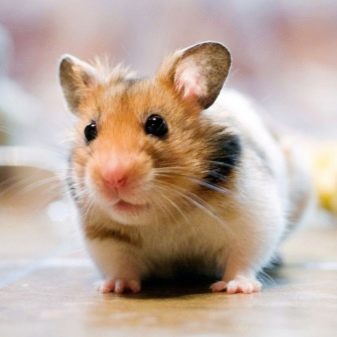
Are water procedures necessary?
When buying a hamster for yourself or your child, you should get the most information about this animal before it appears in the house. The first thing that is important to know is the breeds most suitable for home maintenance, how they look and what the feature is. Then a habitat for the future pet is selected, a place for recreation, active pastime and a food zone is thought out.
In order for the animal to be in conditions comfortable for itself, you need to know about its sleep and wakefulness regime. The most important aspect is animal hygiene, as bathing hamsters is undesirable. In case of contamination of the fur, paws or muzzle, you need to know how to properly clean the pet.
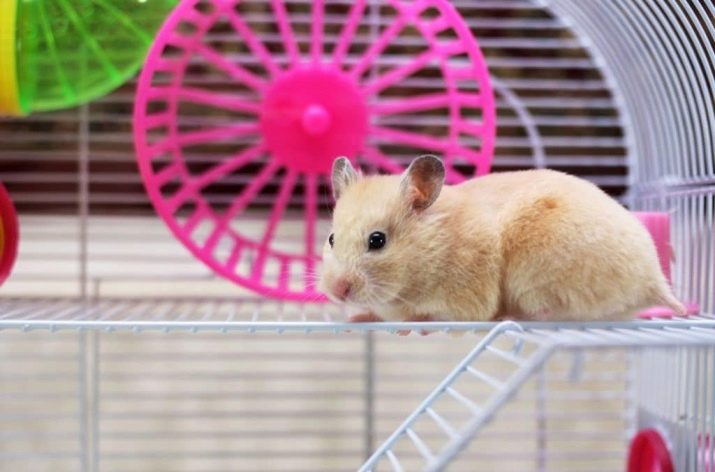
Among the unfavorable factors, due to which it is not necessary to carry out standard water procedures, we can name those described below.
- Stress from staying in the water. Hamsters do not like water and will in every way resist water procedures, which is why the animal will experience severe stress, which can cause a heart attack. In agony, the pet can bite the owner to escape from the water trap, and if it accidentally gets into the water, the hamster will not be able to do anything and will choke.
- Subcooling, which occurs due to wet hair. From this the pet can catch a cold.The result is pneumonia.
- The washing off of a special fat layer from the skin of an animal, which protects it from diseases. If you buy a hamster with shampoo, immunity will become much weaker.
- If the pet gets water in the ear, it will be otitis media, as it is extremely difficult to wipe the ears.
- If the coat is wet, it is rather difficult to dry, and in the wet state, the chances of getting sick increase many times.
- Injuries while taking water procedures. A worried hamster can tear out of his hands and hit a sink or hard table and be injured, which will damage his health.
Thus, hamsters are those pets that are best not to be immersed in water for hygiene. These animals are simply not suitable for swimming, and such a load leads to significant deviations in health, and in the worst case, to cardiac arrest.
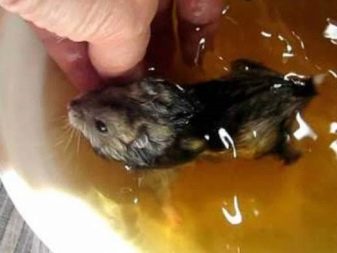

Preparing for a swim
Hamsters in nature live in the steppe, therefore, they are extremely rare with water, which means that they are not used to contact with it. If you have a strong desire to independently monitor the pet’s hygiene, you need to gradually introduce it to the water, showing that it is harmless, and nothing bad will happen to the animal. No need to try to bathe the animal immediately in a large amount of water, since it can be frightened, get out of the hands and drown.
Hamsters are considered clean animals that look after their fur coat up to five times a day, so there is no particular need to bathe them. If the pet is properly maintained and the litter is changed on time, the rodent will not be able to get dirty.
If the animal emits an unpleasant odor, and parasites begin to appear in the hair, then the intervention will be justified. Water for bath procedures should be warm, but not hot. From cool water, the risk of illness increases, from hot - a heart attack can occur. The optimal framework is considered a temperature of 30-35 degrees heat.


Essential Accessories
For the process of adopting water procedures to go smoothly, you need to organize it correctly. The main attribute is a bathing suit, which should be small in size so that the animal is not too scared to be in it. The amount of water should be minimal. You need to wash the animal with a specialized shampoo for hamsters, but if you wish, you can also use means for bathing cats or dogs.
Wash the animal with your hands or use a very soft washcloth so as not to damage the skin of the pet. If you use a kitchen sponge, you can injure the skin, which will lead to the development of allergies or dermatitis. For the convenience of bathing procedures, it is worth having a small bucket with bathing water in it.
When organizing bath procedures, it is very important to close all the windows and doors in the house in order to minimize the risk of drafts, which will inevitably lead to hamster health problems.
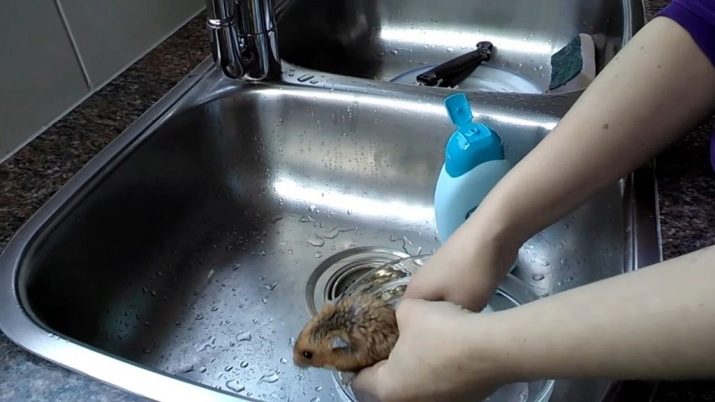
How to wash?
Washing a hamster at home is not too difficult if you have a clear understanding of this procedure. Due to the fact that rodents do not like water, it’s not enough to just bathe them - you need to properly organize a workplace for this and skillfully handle your pet. Knowing the breed of the pet, its character will help to properly set up the hamster and bathe it without any problems.
Depending on the degree of contamination of the animal, there are several options for cleaning it: bathing, using wet wipes or sponges. The first option is needed for serious cases, the second - to help pet hygiene procedures. If you bathe the hamster only in case of real need and correctly approach this procedure, the animal will receive the necessary help and will not suffer in any way. The use of napkins and sponges will minimize stress and maintain the cleanliness and health of the pet.
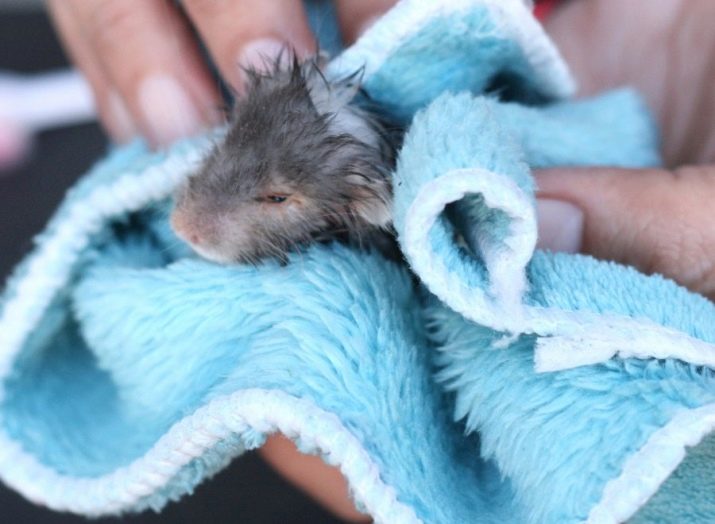
In water
Keeping the hamster at home is not difficult, because the main thing is to feed it and clean it after it. In case of any violations of sanitation, the animal may appear parasites on the fur or an unpleasant odor from the animal itself. If this happens, then you must immediately take measures: bathe the hamster. The sequence of actions will look as described below.
- Preparing a place for swimming. This should be a flat and non-slippery surface on which the bathing set.
- Heating water to the desired temperature. The animal should be comfortable during the procedure.
- You need to have a shampoo for hamsters with you, a soft towel or a cloth for wiping.
- The pet is placed on the plank and is neatly held with one hand, the other at this time gradually pours the prepared water onto the animal.
- While swimming, you can not get the rodent on the head, in the ears, as this is fraught with serious consequences for his health. The procedure is carried out only with the help of hands, without using any hard washcloths or rags so as not to harm the pet.
- Throughout the bathing process, it is important to create an environment that is favorable for the animal. To minimize stress from the procedure, you need to talk to the hamster, calm, communicating calmly and gently. In no case should you allow sharp or loud sounds that can even frighten the animal.
- Starting to wash your pet, it is worth checking that all windows are closed and minimize the risk of drafts, which are very fatal for such small animals.
- Due to the use of special shampoo, it must be washed off well so that there are no residues on the skin and coat that will cause burning and itching in the animal.
- Once the hamster is thoroughly washed, you need to dry it with a towel or napkin. If necessary, you can use a hairdryer, but keep it at a safe distance from the animal.
If you can do without a full bath, then you should choose a more acceptable option for the animal, which will require the availability of some improvised tools and a little time.
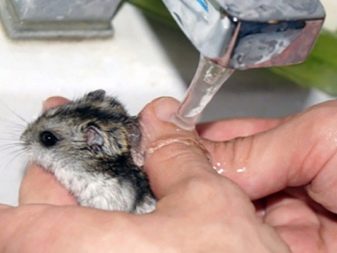

Wet wipes
In the event that the hamster's hygiene procedures were unsuccessful, he fails to clean himself on his own, it is worth interfering and helping him. The most convenient means for this will be cotton pads, which are simply wetted with water and gently act on the contaminated place, eliminating it. It is important to ensure that the water is not cold or too hot - an indicator of 40 degrees is considered the most desirable. If there is no cotton pad or sponge on hand, then you can use wet wipes and clean the animal with them.
Do not take any napkins that are at home, as some of them may contain hazardous chemicals that will harm the pet. It is best to use products for children.
Despite the fact that there is no bathing procedure as such, after wiping it is also important to dry the pet without leaving its coat moist. The choice of wet wipes will be more acceptable for the hamster, as this will not cause him significant discomfort and stress, which means it will not harm. In addition, in this case, the ability to get animal water into the ears is minimized, which is also a definite plus.
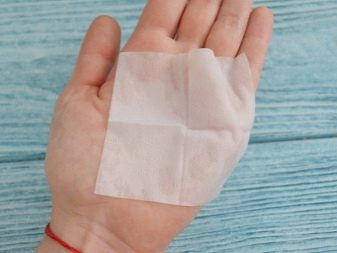

Drying
Regardless of how the bath procedures were carried out, it is worth paying special attention to the drying of the pet. In order for the process to go smoothly, and it was possible to wipe the coat efficiently, it is important to calm the animal by returning it to a calm state. The most effective way is to simply communicate with your pet. At the sound of the owner’s voice, the animal automatically calms down. The main thing is to speak softly and gently, calming the pet.
The safest option for drying the hamster is wrapping it in a soft towel or napkin, which quickly absorbs moisture and poses no threat to the integrity of the skin of the pet.If there is time, it is best to wrap the hamster after bathing and keep it in this state until the fur is completely dry.
In case of a shortage of time, you can try to use a hairdryer, having previously set it to the weakest mode and carefully introducing your pet to a household appliance. If you turn on the device abruptly, and even at full power, the hamster will simply be scared and will run away, or it may even get burns on the skin from contact with too hot air.
If the procedure of bathing, wiping and drying causes great concern, then it is better to abandon them and use an alternative option, for which only sand will be needed.

Sand baths
The use of sand for bathing hamsters is considered the most favorable option for getting rid of any pollution of the pet without causing him physical or psychological harm in the form of stress from meeting with water. To conduct such an event, you need to buy sand at the pet store, which is most often used for chinchillas, as well as a bathing suit in which the hamster will arrange bath procedures.
It is important to monitor the condition of the sand, its purity and the size of the grains. It is recommended to sift the contents of the baton before letting the hamster into it. The container should not be constantly in the cage, otherwise the pet will use it for other purposes, for example, in the form of a toilet or pantry for supplies. Any hygiene procedures should be supervised and supervised. If the animal frolic in the bathing room and left it, you must immediately remove the container with sand and, if necessary, throw it away, replacing it with a new one during the next swimming.

For all its safety, even this procedure can cause some harm to the animal, especially if it is carried out too often. During active movement in the sand, the hamster can inhale small grains of sand, which in large quantities can lead to the development of diseases. Optimal would be a two-time swim a week lasting no more than half an hour. In order for the hamster to enjoy the process, it is important to pour sand with a layer thickness of at least 4-5 cm, so that the animal has the opportunity to dig in it.
If the question arose about choosing the best option for swimming, then it is worth considering a number of advantages of sand baths:
- lack of need for drying of wool after bathing;
- there is no risk of temperature drops and hypothermia, which means that the pet will not get sick;
- the procedure of such swimming positively affects hamsters, bringing them joy, while water causes stress;
- sand baths have not only a hygienic effect, but also help the pet to keep fit due to active actions during bathing.
The choice of this or that option of cleaning hamsters depends on the specific situation, so before making a decision, it is worth assessing the situation and trying the mildest options.
If help the animal immediately failed, you need to look for another option. If possible, contact with water should be eliminated or made as comfortable as possible for the pet.


You will learn more about whether to bathe a hamster and how to do it correctly from the next video.










